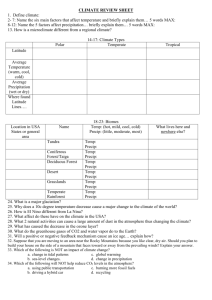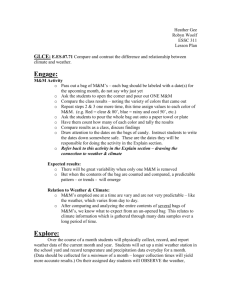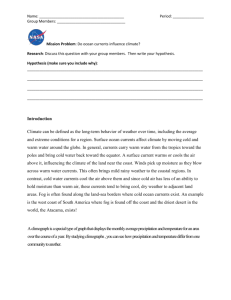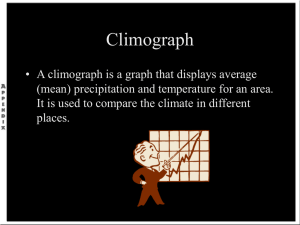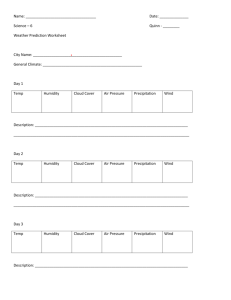Making a Climograph - UCAR Center for Science Education
advertisement
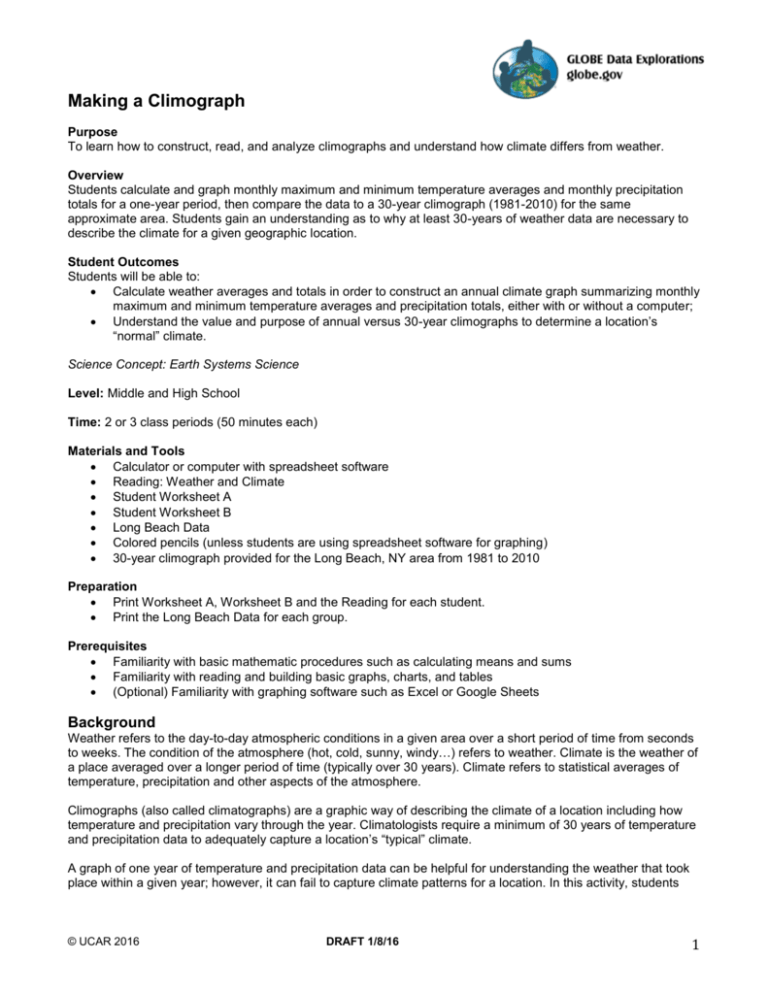
Making a Climograph Purpose To learn how to construct, read, and analyze climographs and understand how climate differs from weather. Overview Students calculate and graph monthly maximum and minimum temperature averages and monthly precipitation totals for a one-year period, then compare the data to a 30-year climograph (1981-2010) for the same approximate area. Students gain an understanding as to why at least 30-years of weather data are necessary to describe the climate for a given geographic location. Student Outcomes Students will be able to: Calculate weather averages and totals in order to construct an annual climate graph summarizing monthly maximum and minimum temperature averages and precipitation totals, either with or without a computer; Understand the value and purpose of annual versus 30-year climographs to determine a location’s “normal” climate. Science Concept: Earth Systems Science Level: Middle and High School Time: 2 or 3 class periods (50 minutes each) Materials and Tools Calculator or computer with spreadsheet software Reading: Weather and Climate Student Worksheet A Student Worksheet B Long Beach Data Colored pencils (unless students are using spreadsheet software for graphing) 30-year climograph provided for the Long Beach, NY area from 1981 to 2010 Preparation Print Worksheet A, Worksheet B and the Reading for each student. Print the Long Beach Data for each group. Prerequisites Familiarity with basic mathematic procedures such as calculating means and sums Familiarity with reading and building basic graphs, charts, and tables (Optional) Familiarity with graphing software such as Excel or Google Sheets Background Weather refers to the day-to-day atmospheric conditions in a given area over a short period of time from seconds to weeks. The condition of the atmosphere (hot, cold, sunny, windy…) refers to weather. Climate is the weather of a place averaged over a longer period of time (typically over 30 years). Climate refers to statistical averages of temperature, precipitation and other aspects of the atmosphere. Climographs (also called climatographs) are a graphic way of describing the climate of a location including how temperature and precipitation vary through the year. Climatologists require a minimum of 30 years of temperature and precipitation data to adequately capture a location’s “typical” climate. A graph of one year of temperature and precipitation data can be helpful for understanding the weather that took place within a given year; however, it can fail to capture climate patterns for a location. In this activity, students © UCAR 2016 DRAFT 1/8/16 1 explore the distinction between one year’s weather data and the average of 30 years of weather data, learning that long-term measurements are important for describing the “normal” climate patterns of a place. Comparing their climograph of one year of data with the 30-year climograph (see examples of each below), students will see how averaging data over many years can dampen the impact of unusual events such as usually dry months or heat waves. They should also notice that missing data makes the precipitation graph less accurate since it is a total for each month rather than an average. About the Data: The temperature and precipitation data that students use in this activity were collected in 2004 by students at Long Beach High School’s NIKE Environmental Center in Long Beach, New York (U.S.) as part of the GLOBE Program. What To Do And How To Do It Step 1: Begin the lesson by asking students the difference between weather and climate. Note their answers on a Venn diagram on the board. Add the following examples: Climate is what we expect. Weather is what we get. (a quote attributed to Mark Twain) Weather determines what you wear. Climate determines the clothes you own. A 30-year climograph (top) and one year (bottom) of high and low temperatures and precipitation for Long Beach, NY, US Step 2: Hand out Reading: Climate and Weather. Have students read about the difference between weather and climate and discuss as a class. Tell students that in this activity they will learn how to make, read, and analyze a climograph for one-year for a given location, then compare it to a 30-year climograph. Step 3: Hand out Student Worksheet A and calculators for each student and the Long Beach Data for each group. Ask students to read the introduction to Long Beach, New York, and use the Long Beach Data. (Note: If you would rather that students use spreadsheet software to do calculations and construct the graph, distribute the data file (.csv format) which is available where you downloaded this activity.) Step 4: Instruct students to create an annual graph of temperature and precipitation data for Long Beach, NY for the year 2004 using the Long Beach Data, colored pencils, and the instructions provided on Student Worksheet A. (Alternatively, have students create the graph using spreadsheet software.) Step 5: Students compare their annual graph with others in their group to ensure accuracy and completeness. Remind students that a climograph usually includes 30 years of data. Ask students whether they think the 30-year climograph will or will not look much like the one-year climate graph that they constructed. Have students write a hypothesis to describe their answer Step 6: Hand out Student Worksheet B. Ask students to compare the climograph that they made with 2004 data with the climograph that uses 30 years of data (shown on Worksheet B). Have students answer the questions on Student Worksheet B individually in preparation for a class discussion. Step 7: Discuss as a class whether one-year of weather data can accurately convey what is “normal” for a specific location? Have students summarize what they learned. © UCAR 2016 DRAFT 1/8/16 2 Assessment Answers on Student Worksheets A and B will indicate whether students are correctly calculating the temperature averages and precipitation totals and whether students understand the reason for averaging more than one year of data to understand climate of a location. Extensions: Delve Deeper into GLOBE Data Have students follow this activity with the Weather Tourists activity from this series of GLOBE Data Explorations. Have students collect min/max air temperature and precipitation data using the GLOBE Atmosphere Protocols and compare a year of their data to a 30-year climograph for your location. Have students create a climate graph with monthly temperature averages and precipitation totals for their city/town or another location of interest. Students can use their own GLOBE temperature and precipitation data for their school in a given year, data assessable from another GLOBE school, or long-term data from locations specified via the GLOBE site. Additional sites with 30-year climographs for comparison purposes with annual climate graphs can be found at: o US Drought Mitigation Center: What Is Climatology? o World Climate © UCAR 2016 DRAFT 1/8/16 3 Name Make a Climograph Student Worksheet A, page 1 Date Long Beach, New York (U.S.) is an oceanfront community located on an island along Long Island’s south shore on the east coast of the United States. Long Beach is located only 40 km from the center of New York City, so it’s convenient for families who live in the city to visit the white sand beaches. MA NY RI CT New York, NY Your assignment is to explore atmospheric data to learn what sort of weather to expect during a visit to Long Beach, New York, at different times of the year. The atmospheric data was collected by students at Long Beach High School’s NIKE Environmental Center in 2004 as part of the GLOBE Program. It’s just one year of data, but it can tell you a lot about what the weather is like at different times of year. PA NJ Long Beach, NY Atlantic Ocean You will calculate annual precipitation totals and mean monthly maximum and minimum temperatures using the Long Beach Data handout. Then you will make a one-year climograph for Long Beach. Part A: Monthly Precipitation Totals: Add each month’s precipitation totals in millimeters (mm) for each month. Record the calculated values in the table below. Part B: Monthly Maximum Temperatures: Add the daily maximum temperatures for each day of the month, and divide the sum by the number of daily measurements made. Record your calculated values in the table below. Part C: Monthly Minimum Temperatures: Add the daily minimum temperatures for each day within the month, and divide the sum by the number of daily measurements made. Record your calculated values in the table below. Month January February March April May June July August September October November December Monthly Precipitation Totals Monthly Maximum Temperatures Monthly Minimum Temperatures Name Make a Climograph Student Worksheet A, page 2 Date Part D: Make a one-year climatograph. You’ll need: three colored pencils (one light color and two darker colors), a ruler, and the graph template below (or spreadsheet software). 1. Make a bar graph of the monthly precipitation totals that you calculated in Part A on the graph below. Make each bar the width of the dotted lines and color it in with a light colored pencil. Color the precipitation square in the key with the color you used for the bar graph. 2. Choose a darker colored pencil and make a dot on the graph to represent the average maximum temperature for each month as you calculated in Part B. Use your ruler to make sure each dot is in line with the name of the month. Connect the dots. Color in the key for average high temperature with the colored pencil. 3. With a different color of pencil, make a dot for each of the average minimum temperature for each month using the values you calculated in Part C. Connect the dots. Color in the key for average low temperature with the colored pencil. 50 0 25 -5 0 -10 Key Dec 5 Nov 75 Oct 10 Sept 100 Aug 15 July 125 June 20 May 150 April 25 March 175 Feb 30 Jan 200 temperature (°C) precipitation (mm) Long Beach, New York (U.S.) Climograph (Made with 2004 GLOBE data) average high temperature average low temperature average monthly precipitation 4. Compare your one-year climate graph to others in your group to ensure that that they look similar. Identify the reason for any differences between graphs. Make a Climograph Reading: Weather and Climate Weather refers to the variations in atmospheric conditions in an area over a short period of time from seconds to weeks. For example, if it is forecast to be sunny and warm tomorrow, that’s weather. Some days are hotter, colder, wetter, or windier. Weather is variable. It changes day-to-day and even hour-to-hour. Climate is the weather of a place averaged over a longer period of time. Climate is the probability that it will be hot and sunny on any given day at a certain time of year. If it is usually sunny and warm in a particular place during a particular season, that’s climate. Climate describes what is usual. To understand the climate of a location, scientists average 30 years of daily weather measurements. Thirty years, with 365 days in each year – that’s 10,950 measurements of daily high temperature, 10,950 measurements of daily low temperature, and 10,950 measurements of precipitation like rain or snow – all to figure out what’s typical for a place. Climographs (also called climatographs) are graphic representations of average temperature and precipitation that are used to describe the climate of a place. A climograph shows two different types of information on the same graph. Take a look at the sample climographs below. Notice that on the x-axis (horizontal) are the months of the year. This is not for a particular year but, rather, an average. Notice that there are two y-axis scales. On the left side is precipitation (in millimeters) and on the right aside is temperature (°C). The bar graph shows the amount of precipitation each month. The line graphs show the average temperature each month. Buenos Aries, Argentina Saskatoon, Canada Climographs courtesy of the National Drought Mitigation Center (U.S.) http://drought.unl.edu/DroughtBasics/WhatisClimatology Name Make a Climograph Student Worksheet B Date 50 0 25 -5 0 -10 Key average high temperature average low temperature average monthly precipitation 1. How are the graphs similar? 2. How are the graphs different? 3. Make a hypothesis about the biggest difference that you see. 4. Can a one-year climate graph accurately convey what is “normal” for a location? 5. Summarize what you have learned today. Dec 5 Nov 75 Oct 10 Sept 100 Aug 15 July 125 June 20 May 150 April 25 March 175 Feb 30 Jan 200 temperature (°C) This is a climograph for Long Beach, NY, made with 30 years of weather data. Compare it with the graph you made using 2004 data on Student Worksheet A. precipitation (mm) Long Beach, New York (U.S.) Climograph (Made with NOAA data from 1981-2010) /RQJ%HDFK'DWDFROOHFWHGDW/RQJ%HDFK+LJK6FKRRO1HZ<RUN86LQ January 2004 Measure Daily Max Date Temp °C 1/1/04 6.7 1/2/04 7.8 1/3/04 8.3 1/4/04 10 1/5/04 9.4 1/6/04 4.4 1/7/04 2.8 1/8/04 -­‐2.8 1/9/04 -­‐1.7 1/10/04 -­‐10 1/11/04 -­‐7.2 1/12/04 0.6 1/13/04 5 1/14/04 5.6 1/15/04 -­‐8.3 1/17/04 -­‐1.7 1/18/04 1.1 1/19/04 1.1 1/20/04 -­‐3.9 1/21/04 -­‐3.3 1/22/04 1.7 1/23/04 2.2 1/24/04 -­‐7.8 1/25/04 -­‐6.1 1/26/04 -­‐7.2 1/27/04 -­‐6.1 1/28/04 -­‐2.8 1/29/04 -­‐2.2 1/30/04 -­‐3.3 Total Days Mean Max °C: February 2004 Daily Min. Temp °C 2.8 2.2 5.6 7.8 1.7 0.6 -­‐8.3 -­‐6.1 -­‐10.6 -­‐17.2 -­‐13.9 -­‐7.8 1.1 -­‐12.8 -­‐13.3 -­‐8.3 -­‐1.7 -­‐6.1 -­‐7.8 -­‐8.9 -­‐5.6 -­‐10.6 -­‐10 -­‐13.9 -­‐10.6 -­‐8.9 -­‐7.8 -­‐6.7 -­‐10 Precip Depth mm 0 0 0.25 0.25 6.86 3.56 0 0 0 0 0 0 0.25 0 0 0 4.83 2.54 0 0 0 0 0 0 0 0 0 0 0 Mean Min °C: Total Precip mm: Measure Date 2/1/04 2/2/04 2/3/04 2/4/04 2/5/04 2/6/04 2/7/04 2/8/04 2/9/04 2/10/04 2/11/04 2/12/04 2/13/04 2/14/04 2/15/04 2/16/04 2/17/04 2/18/04 2/21/04 2/22/04 2/23/04 2/24/04 2/25/04 2/26/04 2/27/04 2/28/04 2/29/04 Total Days March 2004 Daily Max Daily Min. Temp °C Temp °C -­‐2.2 -­‐7.2 2.2 -­‐5.6 6.7 -­‐4.4 5 -­‐1.1 5.6 -­‐4.4 1.7 -­‐2.8 5.6 1.1 4.4 -­‐7.2 2.8 -­‐4.4 6.1 1.7 7.8 0.6 2.8 -­‐2.8 3.3 -­‐0.6 5 0.6 5 -­‐5.6 -­‐1.7 -­‐9.4 -­‐0.6 -­‐5.6 1.1 -­‐2.8 6.1 -­‐1.1 10 1.7 5 -­‐1.7 7.8 0.6 1.7 -­‐5 6.1 -­‐2.2 6.7 -­‐2.8 8.3 -­‐1.1 12.2 2.8 -­‐ Mean Max °C: 1. Mean Min °C: Precip Depth mm 0 0 0 20.32 0 9.4 22.61 0 0 0.51 0 0 0 0 0 0 0 0 0 0 0 0 0 0 0 0 0 Total Precip mm: Measure Date 3/1/04 3/2/04 3/3/04 3/4/04 3/5/04 3/6/04 3/7/04 3/8/04 3/9/04 3/11/04 3/12/04 3/13/04 3/14/04 3/15/04 3/16/04 3/17/04 3/18/04 3/19/04 3/20/04 3/21/04 3/22/04 3/23/04 3/24/04 3/25/04 3/26/04 3/27/04 3/28/04 3/29/04 3/30/04 3/31/04 Daily Max Temp °C 14.4 11.1 13.9 13.9 7.8 8.9 13.3 11.1 5.6 7.2 12.2 4.4 5 11.1 12.8 -­‐0.6 5.6 3.9 5 8.9 8.3 2.8 7.2 8.3 10 14.4 20.6 10 5.6 7.2 Daily Min. Temp °C 6.1 4.4 5 5 3.9 4.4 3.9 -­‐1.1 -­‐1.1 0.6 3.3 -­‐1.7 -­‐2.8 1.7 -­‐1.7 -­‐2.8 -­‐2.2 -­‐1.1 -­‐1.1 2.8 -­‐3.9 -­‐4.4 2.2 4.4 5.6 6.1 7.8 1.1 1.1 3.3 Precip Depth mm 0 0.51 0 3.05 0 6.6 0.25 1.52 1.52 0 0 0 0 0.25 0 0.51 0.76 5.59 0 1.78 0 0 0 1.52 0.25 2.79 0 0 0 27.43 Total Days Mean Max °C: Mean Min °C: Total Precip mm: April 2004 May 2004 Measure Daily Max Date Temp °C 4/1/04 8.3 4/2/04 10 4/3/04 7.2 4/5/04 8.9 4/6/04 6.7 4/7/04 11.1 4/8/04 16.1 4/9/04 16.1 4/10/04 15.6 4/11/04 13.9 4/12/04 10.6 4/13/04 10 4/14/04 12.2 4/15/04 12.8 4/16/04 12.8 4/17/04 17.2 4/18/04 20 4/19/04 18.3 4/20/04 21.7 4/21/04 21.1 4/22/04 15.6 4/24/04 16.7 4/25/04 19.4 4/28/04 16.7 4/29/04 13.9 4/30/04 13.9 Total Days Mean Max °C Daily Min. Temp °C 4.4 5 3.3 -­‐1.7 -­‐1.1 6.1 4.4 4.4 6.1 6.1 5 4.4 6.1 3.9 4.4 5.6 7.8 6.1 10 7.8 7.8 6.1 7.2 3.3 8.3 9.4 Precip Depth mm 9.4 0 3.56 0.25 0 0 0 2.79 0 0.76 0.76 28.19 25.91 7.87 0 0 0 0 0 0 0.25 7.37 0 2.29 0 0 Mean Min °C Total Precip mm Measure Date 5/1/04 5/2/04 5/3/04 5/4/04 5/5/04 5/6/04 5/7/04 5/8/04 5/9/04 5/10/04 5/11/04 5/12/04 5/13/04 5/14/04 5/15/04 5/16/04 5/17/04 5/18/04 5/19/04 5/20/04 5/21/04 5/22/04 5/23/04 5/24/04 5/25/04 5/26/04 5/27/04 5/28/04 5/29/04 5/30/04 5/31/04 Total Days June 2004 Daily Max Temp °C 14.4 15 13.3 12.2 15 17.2 17.2 26.1 14.4 16.7 20 21.7 23.9 22.2 18.9 23.3 23.3 18.3 20 19.4 17.8 19.4 20.6 21.7 17.8 15 21.7 20.6 23.3 20 19.4 Mean Max °C 2. Daily Min. Temp °C 10 11.1 10.6 5.6 8.3 8.9 10 9.4 8.9 10.6 11.1 14.4 15 10.6 12.2 15.6 12.2 12.2 15.6 12.2 13.3 14.4 11.7 13.9 12.8 10.6 11.1 12.8 11.7 11.7 13.3 Precip Depth mm 0 0 2.54 4.57 0 0.25 1.27 0 0.25 0 14.22 0 0.51 0.51 0 6.35 0 2.03 6.6 12.19 3.3 0.25 0 5.33 0.25 1.52 7.87 14.99 5.59 0 0 Mean Min °C Total Precip mm Measure Date 6/1/04 6/2/04 6/3/04 6/4/04 6/5/04 6/6/04 6/7/04 6/8/04 6/9/04 6/10/04 6/11/04 6/12/04 6/13/04 6/14/04 6/15/04 6/16/04 6/17/04 6/24/04 6/27/04 6/28/04 6/29/04 6/30/04 Daily Max Temp °C 18.3 20.6 22.8 22.2 18.9 16.7 19.4 23.9 25 27.8 25.6 21.7 20.6 21.1 25.6 28.3 27.2 24.4 25 25 26.7 23.9 Daily Min. Temp °C 11.1 13.3 16.1 13.3 14.4 11.7 13.3 16.1 17.2 22.2 13.9 13.3 15.6 16.1 17.8 18.9 18.9 17.8 16.1 16.7 16.1 17.8 Precip Depth mm 7.62 0.25 1.27 0 0 4.06 0.25 0 0 0 4.06 0 0 0 0 0 0 0 1.02 0 1.52 0 Total Days Mean Max °C Mean Min °C Total Precip mm: /RQJ%HDFK'DWDFROOHFWHGDW/RQJ%HDFK+LJK6FKRRO1HZ<RUN86LQ July 200 Measure Date 7/1/04 7/2/04 7/3/04 7/4/04 7/5/04 7/6/04 7/9/04 7/10/04 7/11/04 7/12/04 7/13/04 7/14/04 7/15/04 7/16/04 7/17/04 7/18/04 7/19/04 7/20/04 7/21/04 7/22/04 7/23/04 7/24/04 7/25/04 7/26/04 7/27/04 7/28/04 7/29/04 7/30/04 7/31/04 Total Days August 2004 Daily Max Daily Min. Temp °C Temp °C 24.4 18.3 23.9 19.4 26.1 17.8 25 18.9 25 20 26.1 20 27.2 20.6 26.7 18.3 27.2 20 25.6 20 21.1 16.7 22.8 17.8 23.9 18.3 25.6 18.3 26.1 19.4 25.6 20 23.9 20 25 20 29.4 20.6 27.2 21.7 26.7 22.2 23.9 19.4 21.7 18.3 25 17.2 23.3 18.3 22.8 18.9 27.2 19.4 26.7 20.6 26.1 21.7 Mean Max °C Mean Min °C September 2004 Precip Depth mm 0 0 0 0 10.92 0.51 0 0 0 0.51 29.21 0 8.89 0 0 0 1.52 0 0 0 0 3.05 0 0 0 23.37 0.25 0 0 Measure Daily Max Date Temp °C 8/1/04 26.1 8/2/04 26.7 8/3/04 26.7 8/4/04 29.4 8/5/04 31.1 8/6/04 23.3 8/7/04 22.2 8/8/04 22.2 8/9/04 25.6 8/10/04 25 8/11/04 25 8/12/04 24.4 8/13/04 25 8/14/04 23.9 8/15/04 22.8 8/16/04 23.9 8/17/04 23.9 8/18/04 23.9 8/19/04 25.6 8/20/04 25.6 8/21/04 26.7 8/22/04 24.4 8/23/04 23.9 8/24/04 23.9 8/25/04 24.4 8/26/04 22.8 8/27/04 25 8/28/04 26.1 8/29/04 26.1 8/30/04 26.7 Total Precip mm Total Days Mean Max °C 3. Daily Min. Temp °C 21.7 21.7 22.2 21.7 17.8 15.6 14.4 15 18.3 19.4 21.1 20.6 21.7 20 18.9 18.3 16.7 20 21.7 22.2 22.2 14.4 17.2 20 16.7 16.1 20.6 21.1 21.1 22.2 Precip Depth mm 10.16 0 0 0.25 0.25 0 0 0 0 0 0 7.87 0.76 3.56 20.83 15.75 1.52 0 0 0 0 20.07 0 0 0 0 0 0 0 0 Mean Min °C Total Precip mm Measure Date 9/1/04 9/2/04 9/3/04 9/4/04 9/5/04 9/6/04 9/7/04 9/8/04 9/9/04 9/10/04 9/11/04 9/12/04 9/13/04 9/14/04 9/15/04 9/16/04 9/17/04 9/18/04 9/19/04 9/20/04 9/22/04 9/23/04 9/24/04 9/25/04 9/26/04 9/27/04 9/30/04 Total Days Daily Max Temp °C 27.8 27.8 24.4 25 26.1 21.1 25 25.6 23.9 25 26.7 22.2 27.8 26.7 20.6 26.1 25 23.9 19.4 18.9 27.2 27.2 27.2 21.7 25.6 26.1 19.4 Mean Max °C Daily Min. Temp °C 17.2 17.8 17.8 20 17.8 13.9 18.3 21.1 18.9 18.3 16.7 15 17.8 18.9 16.1 18.3 20 16.7 10.6 10.6 15.6 18.3 16.7 16.7 18.3 16.7 13.3 Mean Min °C Precip Depth mm 0 0 0 0 0 0 0 50.04 10.41 0 0 0 0 0 0 1.78 0 1.52 0 0 0 0 0 0 0 0 0 Total Precip mm /RQJ%HDFK'DWDFROOHFWHGDW/RQJ%HDFK+LJK6FKRRO1HZ<RUN86LQ October 2004 November 2004 Measure Date 10/1/04 10/2/04 10/3/04 10/4/04 10/5/04 10/6/04 10/7/04 10/8/04 10/9/04 10/10/04 10/12/04 10/13/04 10/14/04 10/15/04 10/16/04 10/17/04 10/18/04 10/19/04 10/20/04 10/21/04 10/22/04 10/23/04 10/24/04 10/25/04 10/26/04 10/27/04 10/28/04 10/29/04 10/30/04 Daily Max Temp °C 21.1 20.6 19.4 21.1 20 16.1 20.6 21.1 21.1 20 15 17.8 17.2 16.7 16.7 16.1 13.9 14.4 11.7 12.2 12.2 12.2 11.1 12.2 14.4 15.6 15.6 13.3 14.4 Daily Min. Temp °C 13.3 17.2 12.2 12.2 10.6 7.8 11.1 13.9 16.1 15 8.3 8.3 11.7 13.3 10 8.3 7.2 8.3 8.9 8.3 8.3 6.1 8.3 8.3 10.6 8.9 7.2 9.4 12.2 Precip Depth mm 0 0 0 0 0 0 0 0 0 0 0 0 0.25 1.27 3.3 0 0 12.19 0.25 0 0 0 0 0 0 0 0 0 0.76 Measure Daily Max Date Temp °C 11/1/04 22.2 11/2/04 15.6 11/3/04 15 11/4/04 14.4 11/5/04 12.2 11/6/04 12.2 11/7/04 15.6 11/8/04 16.1 11/9/04 10 11/10/04 5.6 11/11/04 11.7 11/12/04 12.8 11/13/04 3.9 11/14/04 5 11/15/04 10 11/16/04 13.9 11/18/04 11.7 11/19/04 16.7 11/20/04 16.1 11/21/04 10.6 11/24/04 11.7 11/25/04 13.3 11/26/04 15.6 11/27/04 9.4 11/28/04 12.2 11/29/04 12.8 Total Days Mean Max °C Mean Min °C Total Precip mm Total Days December 2004 Mean Max °C 4. Daily Min. Temp °C 11.7 7.2 10.6 3.3 7.8 6.7 8.3 6.7 1.7 -­‐1.1 4.4 4.4 0.6 -­‐1.7 2.8 4.4 6.1 10 8.3 6.7 7.8 10.6 -­‐1.1 3.9 8.9 3.9 Precip Depth mm 0 0 0 0 19.3 0 0 0 0 0 0 1.78 17.02 0 0 0 0 0 0 3.81 0.25 4.57 2.29 0 34.04 0.25 Measure Date 12/1/04 12/3/04 12/4/04 12/6/04 12/7/04 12/8/04 12/9/04 12/10/04 12/11/04 12/12/04 12/13/04 12/14/04 12/16/04 12/18/04 12/19/04 12/20/04 12/21/04 12/22/04 12/23/04 12/24/04 12/25/04 12/26/04 12/27/04 12/28/04 12/29/04 12/30/04 12/31/04 Mean Min °C Total Precip mm Total Days Daily Max Daily Min. Temp °C Temp °C 11.7 6.7 7.2 2.2 7.2 -­‐1.1 11.7 0.6 7.2 2.8 13.3 7.2 14.4 4.4 8.3 5.6 9.4 6.7 10.6 3.9 7.2 5 6.7 0.6 2.2 -­‐3.3 7.2 -­‐3.3 7.8 1.1 6.7 -­‐11.1 2.2 -­‐11.7 8.9 -­‐1.1 10.6 7.2 11.7 -­‐1.7 0.6 -­‐4.4 2.2 -­‐4.4 -­‐0.6 -­‐6.7 -­‐2.2 -­‐8.9 2.8 -­‐2.8 7.8 3.3 7.8 1.7 Precip Depth mm 8.64 0 0 0 13.72 8.64 0 9.14 6.35 1.78 0 0 0 0 0 2.03 0 0 0 11.94 0 0 0 0 0 0 0 Mean Max °C Total Precip mm Mean Min °C
